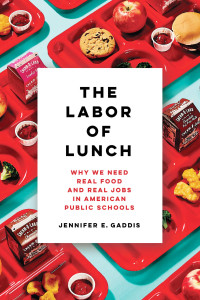[caption id="attachment_10316" align="alignnone" width="200"] GADDIS[/caption]
GADDIS[/caption]
[caption id="attachment_10242" align="alignnone" width="200"] ‘THE LABOR OF LUNCH’: The author spoke to SEIU Local 888 about her work.[/caption]
‘THE LABOR OF LUNCH’: The author spoke to SEIU Local 888 about her work.[/caption]
There is a growing movement across the United States to improve the freshness and quality of school cafeteria food — while improving the quality of the jobs and ensuring better wages and benefits.
“Cafeteria workers are typically left out of the public conversation” on school lunch programs, said Jennifer Gaddis, a University of Wisconsin-Madison professor. She spoke with Local 888 members on a special Zoom call to celebrate National Food Service Worker’s Day.
Gaddis said the coronavirus pandemic has only increased the importance of engaging cafeteria workers who are now widely praised as “essential.” There needs to be a move toward “improving labor conditions, providing hazard pay and guaranteeing sick days” to cafeteria workers, she added.
In 2019, Local 888 along with union and community allies successfully fought to save cafeteria jobs in the Groton-Dunstable Regional School District (See: //www.seiu888.org/2019/05/07/fight-saves-cafeteria-jobs/.) The school board was out to save money by eliminating workers’ health insurance and other benefits, such as vacation time.
Even before this latest wave of school cafeteria outsourcing, many school districts across the U.S. had been persuaded to cut costs by outsourcing preparation work and jobs. Cooking food from scratch has fallen by the wayside in many school cafeterias.
Gaddis spoke about her book, “The Labor of Lunch: Why We Need Real Food and Real Jobs in American Public Schools.” She provide an analysis of how large food companies and chains “have largely replaced the nation’s school cooks by supplying cafeterias with cheap, precooked hamburger patties and chicken nuggets.”
Over time, said Gaddis, “heat-and-serve meals have become more common.” What this has done, she said, is to cut the number of 30- and 40-hour-per-week jobs, including better-paid cooking jobs. That has left the remaining workers with shorter hours that often fail to deliver benefits.
She said she has spoken with older cafeteria workers who recall having such facilities as an onsite bakery — and longer hours when more cooking was done by scratch.
Minneapolis offers a model for adding healthy, local food to school menus, Gaddis said. “They started investing in on-site cooking and created a lot more full-time jobs.”
Gaddis also suggested that school cafeterias could expand their mission in the community to include feeding the homeless and those in need of a good meal.
For more from Gaddis, see her website at //www.jenniferelainegaddis.com/. For a recent article by her on the topic, see https://tinyurl.com/888Gaddis. For more on Minnesota, see https://www.mprnews.org/story/2019/02/28/school-lunch-healthy-local-food-minnesota.
For an article about the presentation see: //www.seiu888.org/cafe/ .
For a video of her presentation (posted on YouTube) https://youtu.be/oQM7CxFT9cE.
